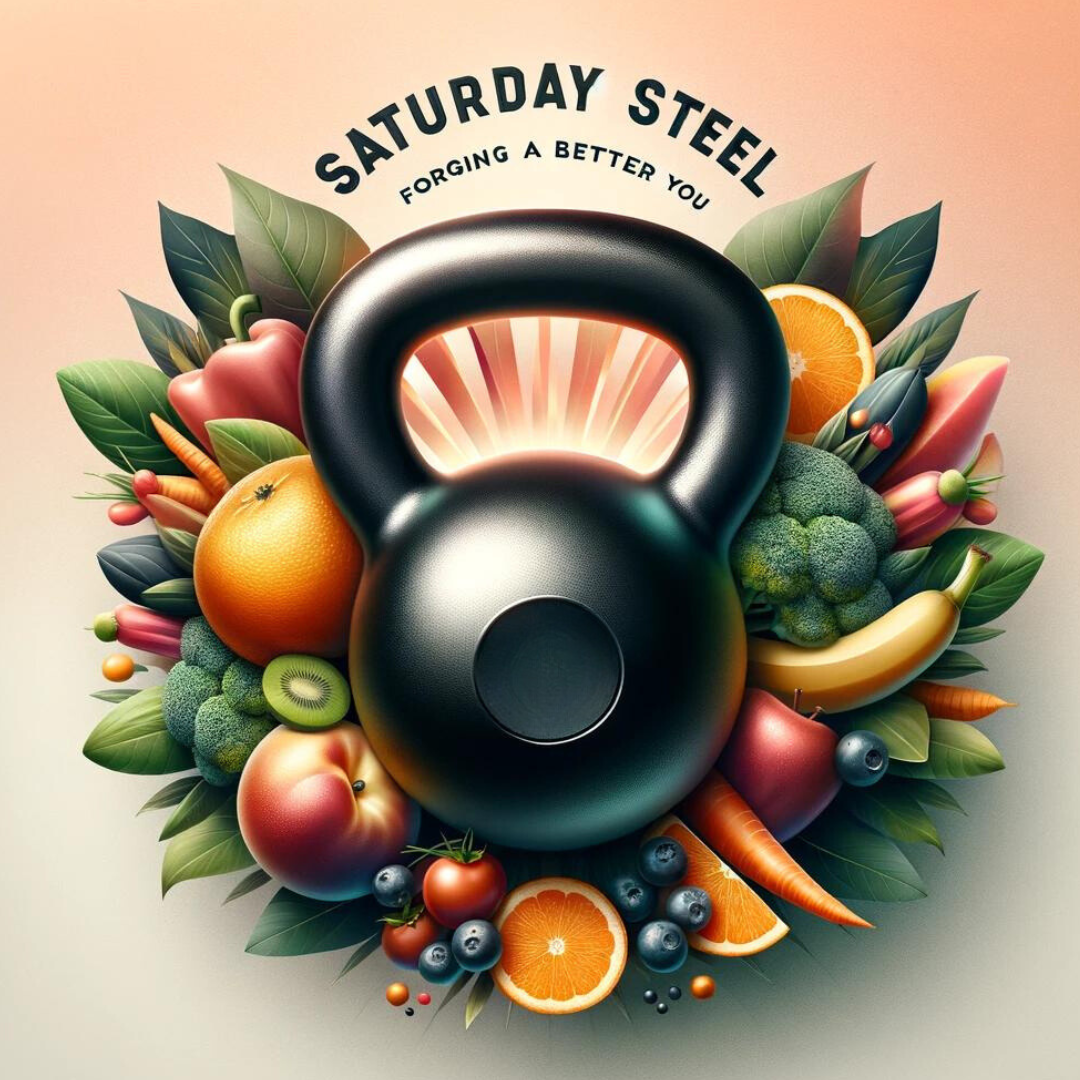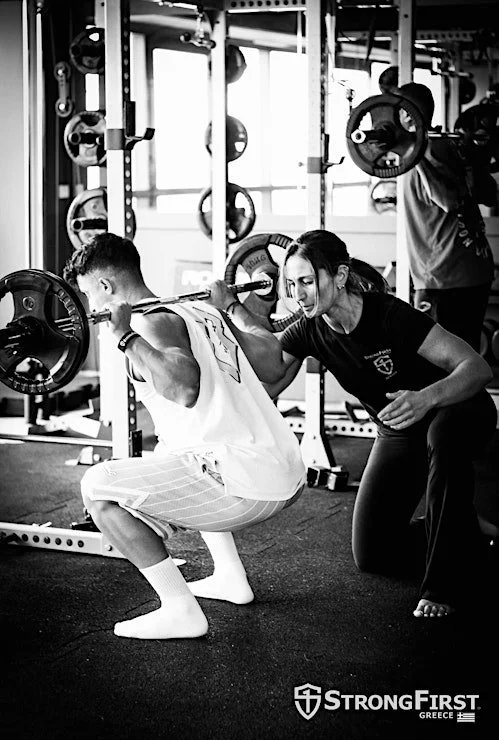Saturday Steel : Marching Towards Wellness
***Every first Saturday of the month, Saturday Steel delivers helpful takeaways on strength, mobility, nutrition topics, and the most effective coaching techniques. (Did some amazing friend forward this to you? Subscribe here.)
Welcome to this month's "Saturday Steel" - where we focus on forging ourselves into better versions, much like the process of forging steel. As we delve into March, let's explore some tips on how to get the most out of kettlebell arm bars as well as our next nutrition habit we’re focusing on this month “Eat enough fruits & veggies”.
💪🛑 Training Tip: The Pitstop Armbar
Are you getting the MOSTEST out of your armbars or are you "going through the motions?" Here is another way to squeeze more out of your armbars: THE PITSTOP ARMBAR . . .
1️⃣ Setup as usual on your back: this is your first "pitstop".
2️⃣ Roll as far as you can onto your side keeping your back foot connected to the floor: this is your second "pitstop".
3️⃣ Bring the back knee down to the floor in front of your belly button (or higher): this is your third "pitstop".
4️⃣ Revisit the previous 2 pitstops on your way back.
5️⃣ Each pitstop is an extra opportunity to practice different resilient shoulder skill sets in different orientations.
Skills such as:
"anti-shrug"/connection
corkscrew
press (floor press becomes bent press along the way in the Armbar)
🤷 Why build resilient shoulders that stay connected, strong, and stable under loads at different angles you ask? …
➡️ Because we want shoulders that are happy & safer when doing Life Things:
pushing away from the floor to get up from sitting on the ground after a picnic
putting a heavy bowl back in the overhead kitchen cupboard
shocking the grandkids when you show them up on the monkey bars
catching the toddler at an unexpected angle before they fall
undoing “computer shoulder & neck” mechanics
less shoulder injuries when doing day-to-day activities
less shoulder injuries when doing sports
better posture and coordination when doing tasks that involve loading the shoulder
shoulders that become more resilient with heavier weight training loads rather than more vulnerable the heavier we train in the gym
Join us in our upcoming KB Strong Start course as we teach & guide you in honing your technique and connection with these foundational kettlebell skills. Our next Kettlebell Strong Start Course is set to commence on March 11th at noon. Register now to secure your spot!
🌱 Nutrition Habit:
Eat Enough Fruits & Veggie
This month, OMP coaches Luis & Mel have been working on eating enough fruits & veggies. We’ve noticed a positive change in energy throughout the day, healthier guts & better focus throughout the workday when eating sufficient amounts of fruits and vegetables.
🤷 Why eat fruits & veggies?
So many reasons! Check out why in this PN article: All About Fruits & Vegetables by coach Luis's mentor Ryan Andrews.
Here are just some of the cool things plants help with:
The antioxidants in plants help curb free radical levels in the body
They contain water and help prevent dehydration
The vitamins and minerals they contain prevent deficiencies - many people develop vitamin deficiencies when not eating enough plants
They reduce the risk of diseases such as cardiovascular disease, asthma, different kinds of cancer, eye disease, high blood pressure, high cholesterol, and more..
They help maintain or improve a healthy body composition
….. read the article to find out more!
*As athletes, OMP coaches have also seen higher quality sports performance, a feeling of well-being, alertness, and endurance when eating appropriate amounts of fruits & veggies.
🔍 What kinds should I eat?
The world of vegetables & fruits is expansive, it can be astonishing to think about how many there are to choose from - just take a look at the List of Vegetables we know are out there:
Level 1
Choose fruits and veggies that you like and can reliably eat often while enjoying the process. If eating enough veggies is a challenge, just stay here and focus on getting enough in! Keep it playful and learn what your preferences are. Maybe you find out that you only like a certain vegetable cooked rather than raw or maybe you find out that when you cut another vegetable up into smaller pieces and combine it with other ingredients, it’s actually not so bad!
For ideas of how to approach veggies if you’re not a fan, try this 3-step approach from this article from Precision Nutrition: What To Do If You Don’t Like Vegetables
1. Challenge - try something new
2. Complement - find things that taste better together
3. Cushion - tone bitterness down with other ingredients
Coach Luis tries to eat at least two large handfuls of vegetables with every meal. He finds it convenient to cook beets and carrots with salt, pepper, and simple spices in the oven for the week.
Level 2
If you easily get enough veggie and fruit material in regularly, the next level is to explore, experiment, and expand your palate to include more “colors” that are missing from your usual rotation. If you’re at this level you’ve probably experimented a bit, grew up with a variety of fruits and veggies or simply have a wide palate of taste interests already. Now it’s time to optimize that palate and use it to further optimize your health!
Optimize your fruit & veggie consumption by including foods that are
GREEN
RED
YELLOW/ORANGE
WHITE
PURPLE/BLUE
Check out this Fruits & Vegetables article for more ideas and examples of each category!
Check out this Fruits & Vegetables article for more ideas and examples of each category!
How much 🤔?
It will depend on each person, their individual needs, and their activity levels but in general it is good to start with the goal of getting 1-2 fist-sized portions of vegetables at each meal according to Precision Nutrition guidelines.
Mel feels the best when she gets 2-3 fist-sized portions of veggies per meal. She often has fruit for dessert.
Luis feels best when he gets in 2 fist-sized portions of veggies per meal.
Using your own hand size to portion food appropriately for you allows for a system that centers on a more intuitive, yet profoundly effective way of accurately estimating vegetable intake to individual needs. The Precision Nutrition guideline recommends incorporating 1-2 fist-sized portions of vegetables at each meal, a simple practice that ensures you harness the full spectrum of vitamins, minerals, and fibers these plant-based powerhouses offer. This approach demystifies the often-overcomplicated narrative around portion sizes, grounding it in the tangible and personal. Instead of weighing your food, counting calories, etc. you can simply use your hand as a tool to estimate portion sizes - and your hand size is unique to you and your needs.

















Stay consistent through the holidays with a simple, sustainable strength plan. We show how often to train (2–3x/week), minimalist bodyweight swaps when traveling, and easy habits for sleep, hydration, and recovery—so your gains stick without stress. Practical holiday fitness tips from Oakland’s Most Powerful Gym.